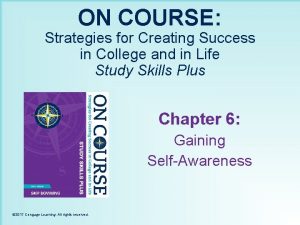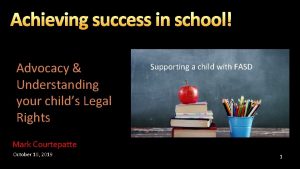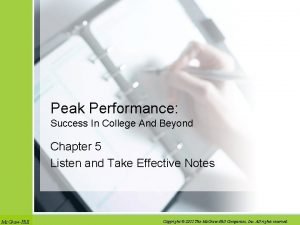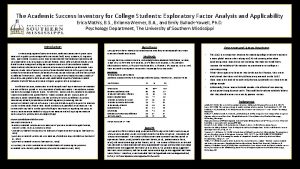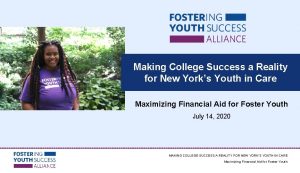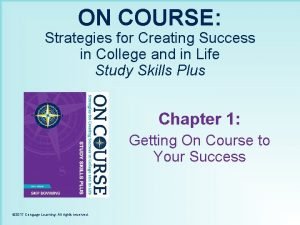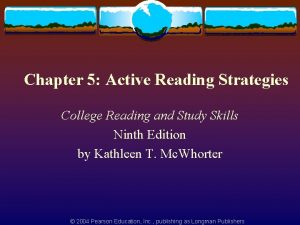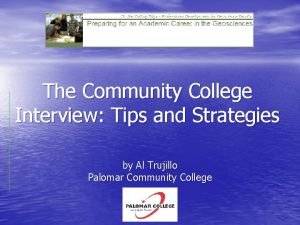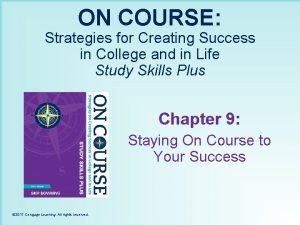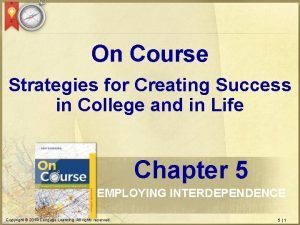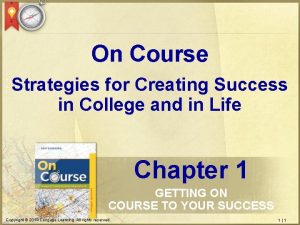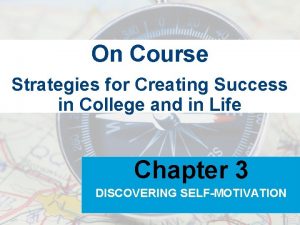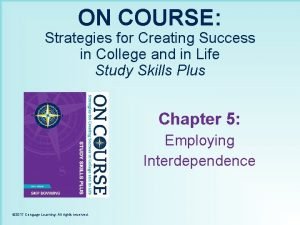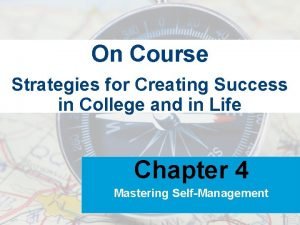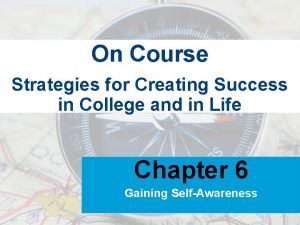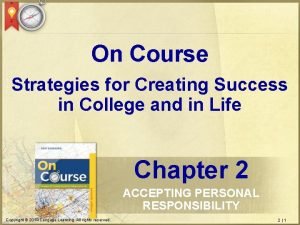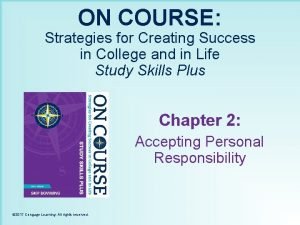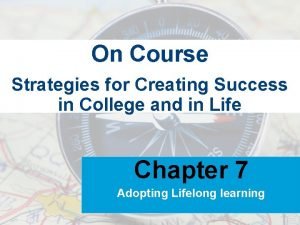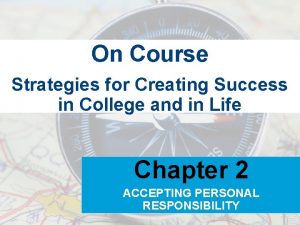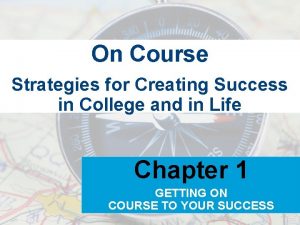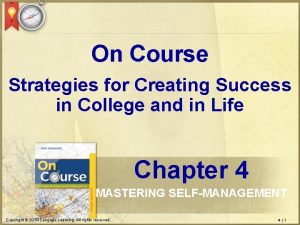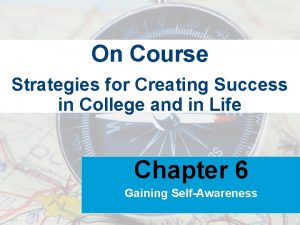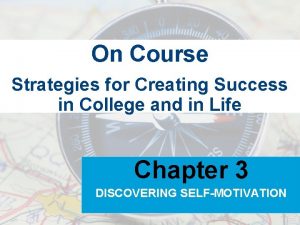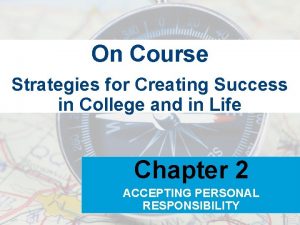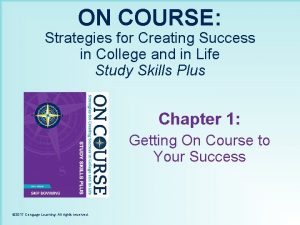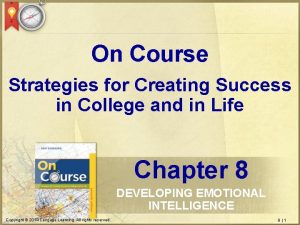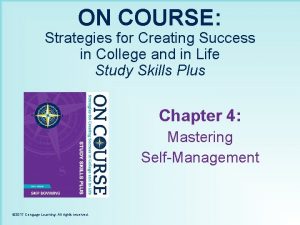On Course Strategies for Creating Success in College







































- Slides: 39

On Course Strategies for Creating Success in College and in Life Chapter 7 ADOPTING LIFELONG LEARNING Copyright © 2014 Cengage Learning. All rights reserved. 7|1

ADOPTING LIFELONG LEARNING The following is a belief of a struggling student. Change it to something that a successful student might believe. ØI avoid new learning experiences. I have a fixed amount of intelligence that may not be up to the challenge. Share your translation with the class. ØEXAMPLE: I have a learning orientation to life. I seek new learning experiences that offer valuable lessons and strengthen my learning muscles for future challenges. Copyright © 2014 Cengage Learning. All rights reserved. 7|2

ADOPTING LIFELONG LEARNING The following is a belief of a struggling student. Change it to something that a successful student might believe. ØI often experience frustration, boredom or resistance when instructors don’t teach the way I prefer to learn. Share your translation with the class. ØEXAMPLE: I discovered my preferred way of learning. I utilize strategies that allow me to maximize my learning of valuable new information and skills. Copyright © 2014 Cengage Learning. All rights reserved. 7|3

CASE STUDY IN CRITICAL THINKING A FISH STORY • Read the case study “A Fish Story. ” Ø Why do you think the biology professor didn’t simply tell the students what he wanted them to learn? Copyright © 2014 Cengage Learning. All rights reserved. 7|4

A FISH STORY: DIVING DEEPER Think of a time in your life when you became as involved in your learning as did the students in the biology class. Perhaps you were working on a project, pondering a new idea, involved in a debate or engaged in a deep conversation. ØWhat motivated you to become so involved? Ø How could you experience that same level of motivation in your current college courses? Copyright © 2014 Cengage Learning. All rights reserved. 7|5

CRITICAL THINKING: FOCUS QUESTION DEVELOPING A LEARNING ORIENTATION TO LIFE • How can you maximize your learning in college and in life? Voronin 76 Copyright © 2014 Cengage Learning. All rights reserved. 7|6

GROWTH MINDSET AND FIXED MINDSET Learners with a fixed mindset believe people are born with a fixed amount of ability and talent. Learners with a growth mindset believe their ability and talent get stronger the more they are used. Identify the following statements as a fixed mindset or as a growth mindset. Ø I made an “A” in math because I am smart! Fixed Mindset Ø I made an “A” in math because I worked hard! Growth Mindset Copyright © 2014 Cengage Learning. All rights reserved. 7|7

HOW TO DEVELOP A GROWTH MINDSET Make a list of strategies you could use to develop a growth mindset? How many of the following do you have on your list? Ø Think of your brain as a muscle that gets stronger with exercise. Ø Set learning goals as well as performance goals. Ø Seek feedback to deepen your learning. Ø Change course when needed. What other strategies do you have on your list? Copyright © 2014 Cengage Learning. All rights reserved. 7|8

CRITICAL THINKING: FOCUS QUESTIONS DISCOVERING YOUR PREFERRED WAYS OF LEARNING • What is your preferred way of learning? • What can you do when your instructor doesn’t teach the way you prefer to learn? Mjak Copyright © 2014 Cengage Learning. All rights reserved. 7|9

SELF-ASSESSMENT: HOW I PREFER TO LEARN • Complete the Learning Preference Inventory in On Course and calculate your scores. ØDid anything surprise you about the results? ØHow can you use this information to help you in college? Elligren Copyright © 2014 Cengage Learning. All rights reserved. 7 | 10

PREFERRED WAYS OF LEARNING Match the preferred ways of learning to their correct descriptions. Ø Asks “what? ” questions. Ponders facts and theories. Innovating Learner Ø Asks “how? ” questions. Enjoys taking action. Feeling Learner Ø Asks “why? ” or “who? ” questions. Enjoys personal connections. Thinking Ø Asks “what if? ” or “what else? ” questions. Imagines new possibilities and making unexpected connections. Copyright © 2014 Cengage Learning. All rights reserved. Learner Doing Learner 7 | 11

PREFERRED WAYS OF LEARNING Identify the preferred way of learning described below: Learns well with lectures, visual aids, Thinking Power. Point Learner slides, and textbook readings. Learns well in a safe and accepting classroom Feeling atmosphere. Learner Copyright © 2014 Cengage Learning. All rights reserved. Learns well with hands on work in guided labs or Doing practice Learner applications. Learns well when encouraged to use Innovating intuition to Learner create something new. 7 | 12

CRITICAL THINKING: FOCUS QUESTIONS EMPLOYING CRITICAL THINKING • How can you determine the truth in this complex and confusing world? • How can you present your truths in a way that is logical and persuasive to others? Milous. SK Copyright © 2014 Cengage Learning. All rights reserved. 7 | 13

EMPLOYING CRITICAL THINKING • What are two skills that are essential to employing critical thinking. Constructing logical arguments Copyright © 2014 Cengage Learning. All rights reserved. Asking probing questions 7 | 14

CONSTRUCTING LOGICAL ARGUMENTS When constructing a logical argument, what three components are essential? • Reasons ØPremises, Claims, Assumptions ØAnswers "Why? ” • Evidence ØSupport: Facts, Data, Stories ØAnswers "How do you know? ” • Conclusions ØOpinions, Beliefs, Positions ØAnswers "What should the audience think or do? ” Copyright © 2014 Cengage Learning. All rights reserved. 7 | 15

APPLYING THE CONCEPT Imagine that a friend presents you with the argument below. As a critical thinker, what probing questions might you ask about his reason, evidence, and conclusion? [Reason] I’ve decided that I’m not really college material. [Evidence] I’m taking four courses and it looks like I’m going to get only one B and three D’s. [Conclusion] I think I’ll drop out before I flunk out. Copyright © 2014 Cengage Learning. All rights reserved. 7 | 16

LIFELONG LEARNING AT WORK • Form groups of three. • Discuss what kind of information you could obtain about possible careers if you asked probing questions, employed critical thinking skills and utilized lifelong learning strategies. • Share your results with the rest of the class. Copyright © 2014 Cengage Learning. All rights reserved. 7 | 17

CRITICAL THINKING: FOCUS QUESTIONS DEVELOP SELF-RESPECT • What is your present level of self-respect? • How can you raise your self-respect, and therefore your self-esteem, even higher? Copyright © 2014 Cengage Learning. All rights reserved. 7 | 18

LIVE WITH INTEGRITY We create integrity by choosing words and deeds that are aligned with our values. Discuss the following questions with a partner. • On a scale of 1 -10 (10 high), how much do you value your education? • What choices of yours are aligned with the value you place on your education? • What choices of yours are not aligned with the value you place on education? • Are there any changes you plan to make to bring your choices into greater alignment with your values? Copyright © 2014 Cengage Learning. All rights reserved. 7 | 19

KEEP COMMITMENTS • Think about a personal commitment you have been wanting to make. Perhaps you want to study more, quit smoking, or spend less money. Answer the following questions so you will be prepared when you are ready to make the commitment. Ø How can you make your agreement consciously? Ø How can you use Creator language when making this commitment? Ø How can you make your agreement important? Ø How can you create a plan and do everything in your power to carry out the plan? Ø If you were to experience problems, how could you renegotiate your commitment? • Share your answers with the rest of the class. Copyright © 2014 Cengage Learning. All rights reserved. 7 | 20

QUICK REVIEW Identify the following statement as an example of a growth mindset or as a fixed mindset. Ø I will never be college material. Ø If I study a lot, I will do fine in college. Fixed Mindset Growth Mindset Ø Math has always been easy for me because I’m smart. Fixed Mindset Ø Math has always been easy for me because I work hard at it. Growth Mindset Copyright © 2014 Cengage Learning. All rights reserved. 7 | 21

QUICK REVIEW What are the four preferred ways of learning? Thinking Innovating Doing Feeling Copyright © 2014 Cengage Learning. All rights reserved. 7 | 22

QUICK REVIEW What are two skills essential to employing critical thinking? Constructing logical arguments Copyright © 2014 Cengage Learning. All rights reserved. Asking probing questions 7 | 23

QUICK REVIEW Match the three components of a logical argument to their description. Reasons ØAnswers “How do you know? ” Evidence ØAnswers “Why should the audience think or do something? ” Conclusions ØAnswers “What should the audience think or do? ” Copyright © 2014 Cengage Learning. All rights reserved. 7 | 24

QUICK REVIEW Identify five strategies for keeping commitments: Make your agreements consciously. Use creator language. Make your agreements important. Create a plan; then do everything in your power to carry out your plan. Copyright © 2014 Cengage Learning. All rights reserved. If a problem arises or you change your mind, renegotiate. 7 | 25

On Course Strategies for Creating Success in College and in Life Chapter 7 Wise Choices in College WRITING Copyright © 2014 Cengage Learning. All rights reserved. 7 SS | 26

WISE CHOICES IN COLLEGE: WRITING • What are the four components in the writing process? ØPrewriting ØWriting ØRevising ØEditing Brian A Jackson Copyright © 2014 Cengage Learning. All rights reserved. 7 SS | 27

WISE CHOICES IN COLLEGE: WRITING • Match the four components of writing to their correct description. Ø Includes any preparation you do before actually writing. Writing Ø Turns your raw materials into a document that achieves your defined purpose. Editing Ø Helps to identify what you don’t understand encourages you to think more critically. Ø Eliminates surface problems (errors in grammar, sentence structure and spelling). Copyright © 2014 Cengage Learning. All rights reserved. Revising Prewriting 7 SS | 28

STRATEGIES TO IMPROVE WRITING: BEFORE WRITING • You have learned that affirmations are important self-talk. Create an affirmation that you will say before you begin writing. • Share your affirmation with the person sitting next to you. kentoh Copyright © 2014 Cengage Learning. All rights reserved. 7 SS | 29

STRATEGIES TO IMPROVE WRITING: BEFORE WRITING • What’s a good strategy for collecting ideas on the spur of the moment? ØCarry index cards with you. • What’s a good strategy for guiding your collection of information? ØCreate focus questions that arouse your curiosity. Perhaps write them on index cards. Copyright © 2014 Cengage Learning. All rights reserved. 7 SS | 30

STRATEGIES TO IMPROVE WRITING: BEFORE WRITING What are some sources for collecting information? ØDiscuss your topic with others. Start by asking focus questions and follow where they lead. ØSeek ideas and supporting details in your campus library. ØSearch the internet for more ideas and supporting details. Copyright © 2014 Cengage Learning. All rights reserved. 7 SS | 31

STRATEGIES TO IMPROVE WRITING: BEFORE WRITING • What strategies could you use to start organizing your information? Ø Group your notes: Sort information into piles, with one pile for each main idea or focus question. Ø Identify your audience: Once you know the audience, use that information to decide what information to include/exclude, how much evidence is needed, and whether to write formally/informally. Ø Define your thesis: Identify the most important idea you want to convey. Everything else should support this idea by answering questions a reader might have. Ø Create a plan: Use an outline, concept map, or question outline. • Compare your answers to those listed in On Course. Copyright © 2014 Cengage Learning. All rights reserved. 7 SS | 32

STRATEGIES TO IMPROVE WRITING: WHILE WRITING • Write a “hook” for an essay about how to be successful in college. Your goal is to make your reader want to hear more. • Your “hook” could be a question, a quotation, something humorous, surprising data, a shocking statement, or a fascinating story. • Pair up and read your hooks to each other. • Ask your listener for suggestions to improve your hook. • Nominate your partner to share his or her hook with the class. Copyright © 2014 Cengage Learning. All rights reserved. 7 SS | 33

STRATEGIES TO IMPROVE WRITING: WHILE WRITING • Now that you have your reader “hooked”, what are the next steps for completing your introduction? Ø Add your thesis statement: The key concept about which you are writing. Ø Write an agenda: State the main ideas that the reader can expect to encounter. • Compare your answers with a partner. Copyright © 2014 Cengage Learning. All rights reserved. 7 SS | 34

STRATEGIES TO IMPROVE WRITING: WHILE WRITING What are additional elements you can include in the rest of your composition? Ø Support: Include your secondary ideas and supporting details. These are often examples, experiences, explanations, and evidence (4 E’s). Ø Transitions: Use words, phrases or sentences that act as bridges between ideas. Ø Refutation in a persuasive essay: Dispute any reasons that someone would be resistant to what you want them to think or do. Ø Satisfying conclusion: Summarize the main points you have made or echo the hook. Copyright © 2014 Cengage Learning. All rights reserved. 7 SS | 35

STRATEGIES TO IMPROVE WRITING: AFTER WRITING • Yesterday you finished a paper that you spent many hours writing. What actions should you take before turning in your final paper? Ø Revise Ø Cite sources Ø Read aloud Ø Edit carefully Ø Seek help • Share your results with a partner i. Qoncept Copyright © 2014 Cengage Learning. All rights reserved. 7 SS | 36

STRATEGIES TO IMPROVE WRITING: AFTER WRITING • After you receive a graded paper back, what strategies will help you improve your writing? Ø Keep an error log: record every sentence in which you had a grammar or punctuation problem, write the sentence with all corrections, and record the grammar or punctuation rule. Ø Rewrite graded papers: use the instructor’s feedback to improve your writing. Show the revision to your instructor; you may even receive a higher grade. • Compare your answers to those listed in On Course. Copyright © 2014 Cengage Learning. All rights reserved. 7 SS | 37

CREATING AN ACADEMIC SKILLS PLAN FOR WRITING • Make a list of the biggest challenges you have had with writing assignments. Ø Look over strategies for Writing. ØChoose three strategies that you will use. ØExplain to a partner the three strategies that you have chosen and why. Copyright © 2014 Cengage Learning. All rights reserved. 7 SS | 38

End Chapter Seven Copyright © 2014 Cengage Learning. All rights reserved. 7 | 39
 On course strategies for creating success in college
On course strategies for creating success in college By listening to my inner defender voice i can be sure that
By listening to my inner defender voice i can be sure that Your child's success or lack of success
Your child's success or lack of success Your child's success or lack of success
Your child's success or lack of success Peak performance success in college and beyond
Peak performance success in college and beyond High school gpa as predictor of college success
High school gpa as predictor of college success The academic success inventory for college students
The academic success inventory for college students Foster youth college success initiative
Foster youth college success initiative On course strategies
On course strategies T junction flemish bond
T junction flemish bond Course number and title
Course number and title Chaine parallèle muscle
Chaine parallèle muscle Active reading strategies college
Active reading strategies college College interview tips and strategies
College interview tips and strategies Kontinuitetshantering i praktiken
Kontinuitetshantering i praktiken Typiska novell drag
Typiska novell drag Tack för att ni lyssnade bild
Tack för att ni lyssnade bild Vad står k.r.å.k.a.n för
Vad står k.r.å.k.a.n för Shingelfrisyren
Shingelfrisyren En lathund för arbete med kontinuitetshantering
En lathund för arbete med kontinuitetshantering Adressändring ideell förening
Adressändring ideell förening Personlig tidbok
Personlig tidbok A gastrica
A gastrica Vad är densitet
Vad är densitet Datorkunskap för nybörjare
Datorkunskap för nybörjare Boverket ka
Boverket ka Debatt mall
Debatt mall För och nackdelar med firo
För och nackdelar med firo Nyckelkompetenser för livslångt lärande
Nyckelkompetenser för livslångt lärande Påbyggnader för flakfordon
Påbyggnader för flakfordon Tryck formel
Tryck formel Offentlig förvaltning
Offentlig förvaltning Jag har nigit för nymånens skära
Jag har nigit för nymånens skära Presentera för publik crossboss
Presentera för publik crossboss Vad är ett minoritetsspråk
Vad är ett minoritetsspråk Vem räknas som jude
Vem räknas som jude Klassificeringsstruktur för kommunala verksamheter
Klassificeringsstruktur för kommunala verksamheter Luftstrupen för medicinare
Luftstrupen för medicinare Bästa kameran för astrofoto
Bästa kameran för astrofoto Centrum för kunskap och säkerhet
Centrum för kunskap och säkerhet
